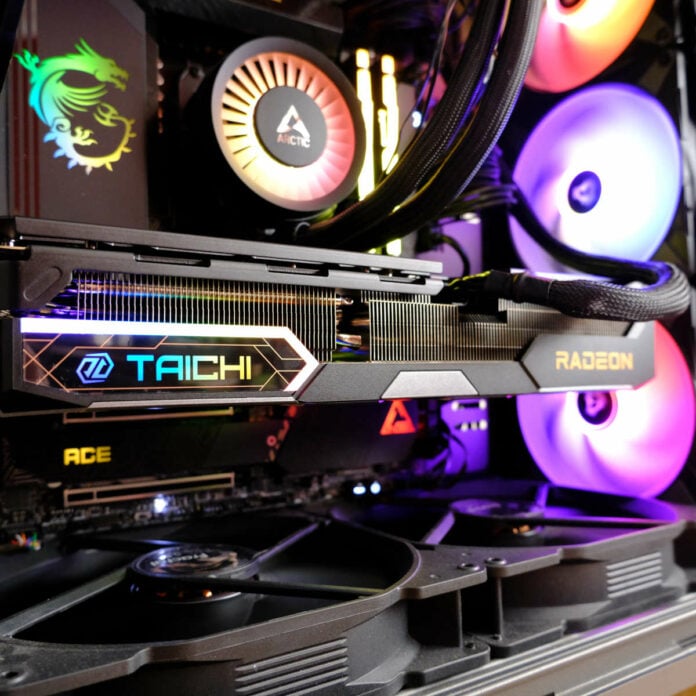There’s plenty to love about the latest AMD RDNA 4 GPUs but models like ASRock Radeon RX 9070 XT Taichi OC aim to put a finer shine on the silicon. It’s a noble albeit costly venture that the card handily carries out in style.
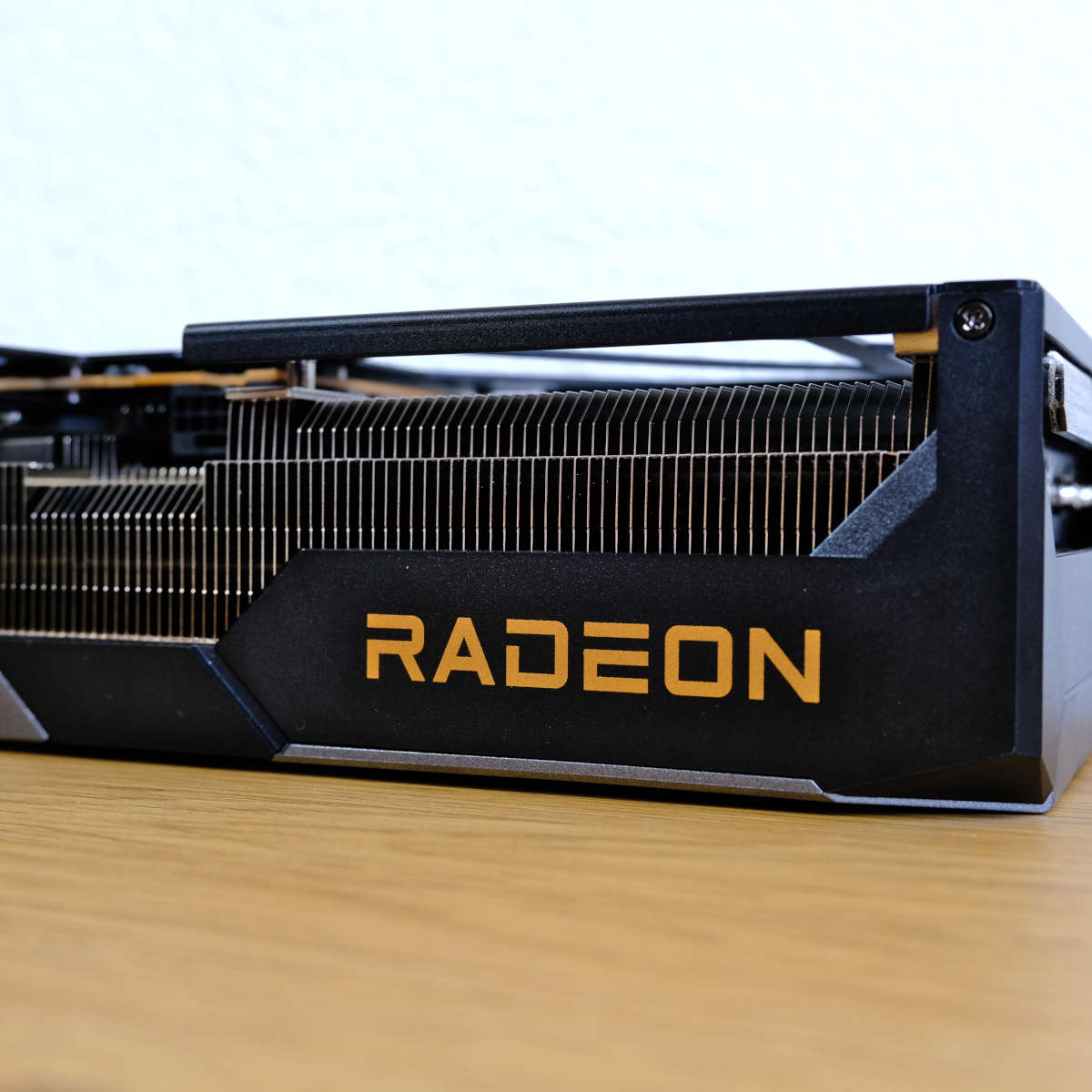

ASRock Radeon RX 9070 XT Taichi OC
£730 / $730
Pros
- Great QHD and UHD performance
- Solid raster and ray tracing
- Healthy 16GB VRAM buffer
- FSR 4 upscaling is great
- Stylish, brilliant cooler
Cons
- Few FSR 4 games for the moment
- Not as feature-rich as RTX rivals
- Relatively power hungry
- $130 / £160 above MSRP
Club386 may earn an affiliate commission when you purchase products through links on our site.
How we test and review products.
Much as MSRP feels like a somewhat moot metric in the current market, it will become more important again once demand cools and supply constraints ease. This keeps the intended pricing of Taichi OC, specifically £730 / $730, and other models important to assess value both at that cost and with relevance to its current going rate.
With all the above in mind, ASRock has crafted a Radeon RX 9070 XT through Taichi OC that’s more marvellous than modest and certainly warrants a premium.
Specifications
ASRock pushes beyond AMD’s reference Radeon RX 9070 XT with its Taichi OC model, providing a healthy boost to the card’s game and boost clocks. Naturally, this results in a small bump to AI and gaming performance, but these gains come at the cost of higher power consumption.
| Radeon | RX 9070 XT Reference | RX 9070 XT Taichi OC |
|---|---|---|
| Released | March 2025 | March 2025 |
| Codename | RDNA 4 | RDNA 4 |
| GPU | Navi 48 | Navi 48 |
| Process | TSMC N4P (4nm) | TSMC N4P (4nm) |
| Transistors | 53.9bn | 53.9bn |
| Die size | 357mm2 | 357mm2 |
| Stream processors | 4,096 | 4,096 |
| Game clock | 2,400MHz | 2,570MHz |
| Boost clock | 2,970MHz | 3,100MHz |
| Compute units | 64 of 64 | 64 of 64 |
| RT accelerators | 64 (3rd Gen) | 64 (3rd Gen) |
| AI accelerators | 128 (2nd Gen) | 128 (2nd Gen) |
| Peak FP32 TFLOPS | 49 | 51 |
| Peak FP16 TFLOPS | 97 | 102 |
| ROPS | 128 | 128 |
| Memory | 16GB | 16GB |
| Mem. type | GDDR6 | GDDR6 |
| Mem. clock | 20Gb/s | 20Gb/s |
| Mem. interface | 256-bit (PCIe Gen 5) | 256-bit (PCIe Gen 5) |
| Mem. bandwidth | 640GB/s | 640GB/s |
| Board power | 304W | >304W |
| Launch MSRP | $599 | $730 |
In the table above, I’ve highlighted in bold the differences between AMD’s reference specifications and ASRock’s changes. For more details on RDNA 4 architecture and the wider GPU specs, read my Sapphire Nitro+ Radeon RX 9070 XT review.
Taichi OC comes out of the box with game and boost clocks that are respectively 7% and 4% higher than stock. It’s in hallowed company, as its peak 3,100MHz is the highest on the market.
While the effect of clock speed increases will vary depending on application, it does push the theoretical peak FP32 and FP16 TFLOPs of the card. More specifically, it enjoys increases of 4-5% in this regard.
ASRock doesn’t list the wattage of its flagship Radeon RX 9070 XT, but it’s undoubtedly running beyond the GPU’s 304W reference specification. Given its clock speeds, I’m confident this is AMD’s top-of-the-line 340W variant.
As one of the finest examples of Radeon RX 9070 XT, it should come as no surprise that Taichi OC is also among the most expensive. At £730 / $730, it’s more than 20% above AMD’s SEP (Suggested Etail Price) and places the card’s cost dangerously close to Nvidia GeForce RTX 5070 Ti (providing you can actually find one at its MSRP).
Design
Mirroring motherboards flying under the same family, Taichi OC rocks a black-and-gold colour scheme that befits its opulent character. It’d feel right at home inside Deus Ex protagonist Adam Jensen’s rig. The broader design and shape of the card is pleasing to the eye too, to the point that I’d go so far as to say it’s my favourite on the market.
The pixel pusher is pretty but certainly not petite, with measurements at 330mm (L) x 140mm (W) x 61mm (H). To ASRock’s credit, this is smaller than its previous flagship design but you’ll still need three slots spare to get into your system.
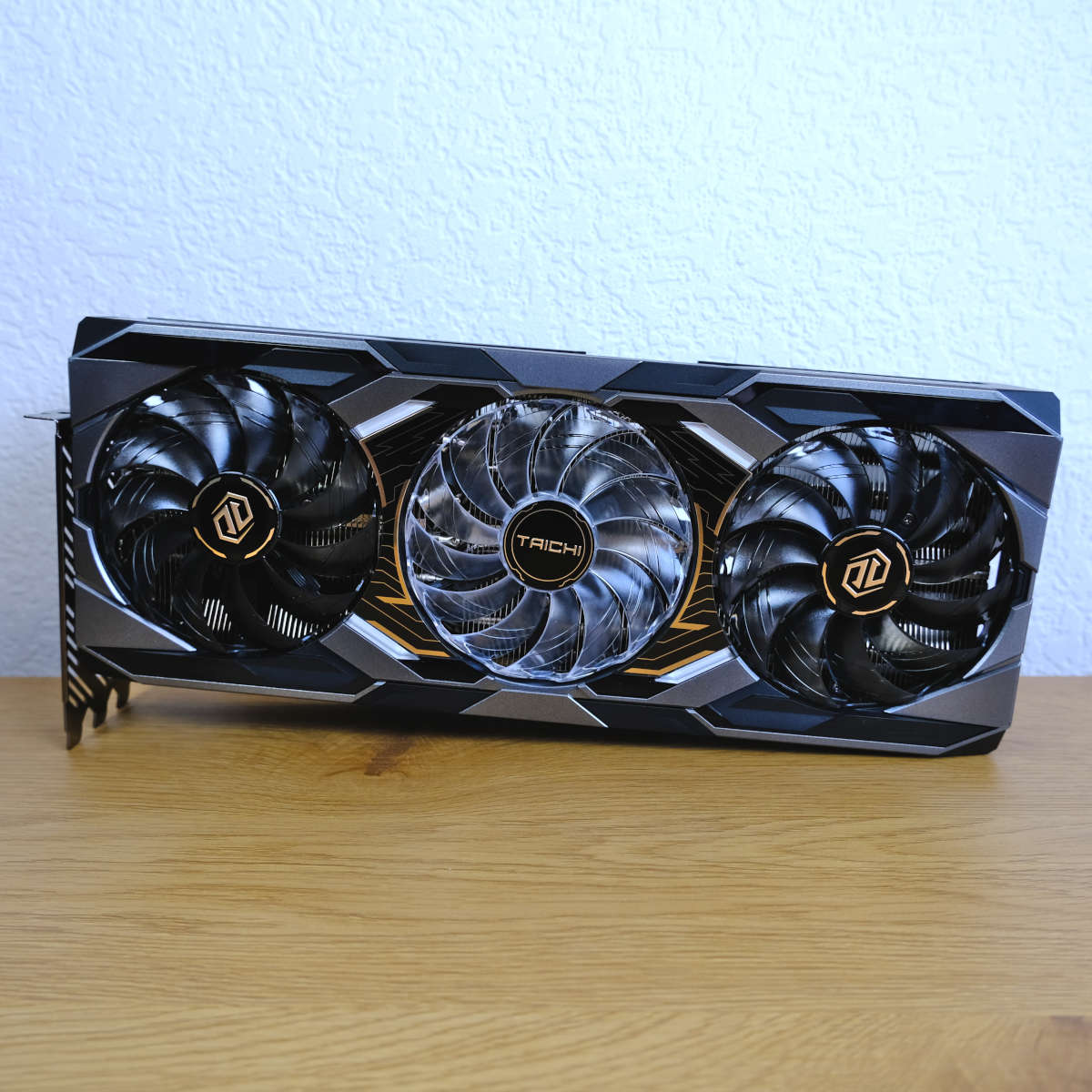
This Taichi OC is also lighter than its predecessor at 1,554g, shaving 346g across generations. This still leaves it on the heavier side but the metal stand ASRock includes in the box does an ample job of keeping any sag at bay. Said accessory also doubles up as a screwdriver if you separate the rising part from its base, saving you from grabbing your toolkit should you need to remove the card.
Hefty as this Radeon RX 9070 XT is, it’s not without just cause. Underneath its shroud lies a beefy heatsink with heatpipes and fins aplenty to dissipate heat from the GPU. That’s not forgetting the materials of the cooler itself which combines high-quality plastics and metal. This is all to say it looks and feels as good as it performs.
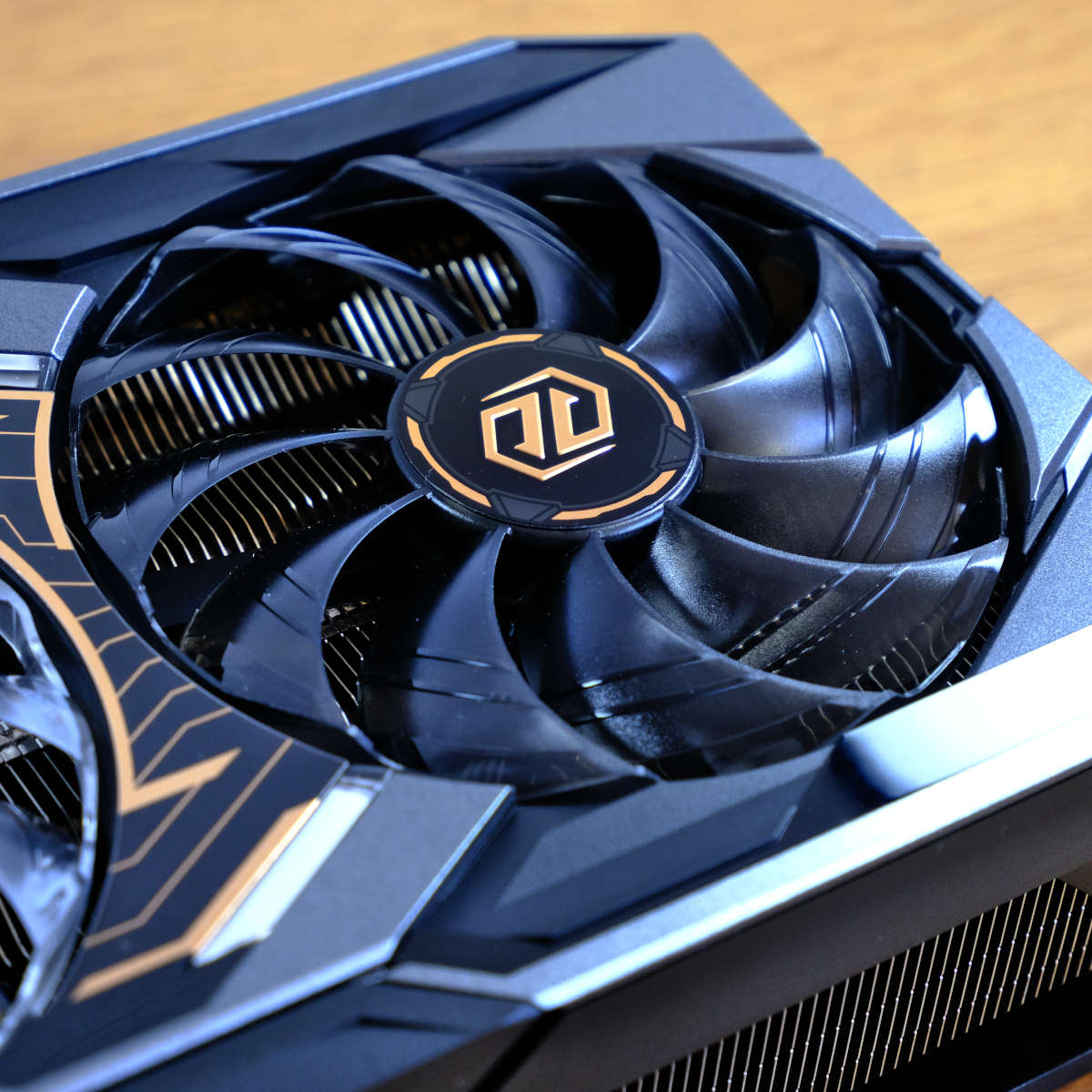
Three of ASRock’s ‘Striped Ring Fans’ keep Taichi OC cool. The outer two blowers spin clockwise and don the same black-and-gold colour scheme as the rest of the card. However, the middle fan spins anti-clockwise in a bid to improve airflow throughout the heatsink. All contain semi-transparent blades that boost the profile of its ARGB LEDs.
Truthfully, I would prefer ASRock forgo RGB on its fans to maintain a more uniform design. The rectangular LEDs surrounding the centre blower combined with the ‘Taichi’ banner along the side of the shroud are enough for me. However, I concede that not everyone will share my preferences and I’ve little doubt many others will appreciate this approach.
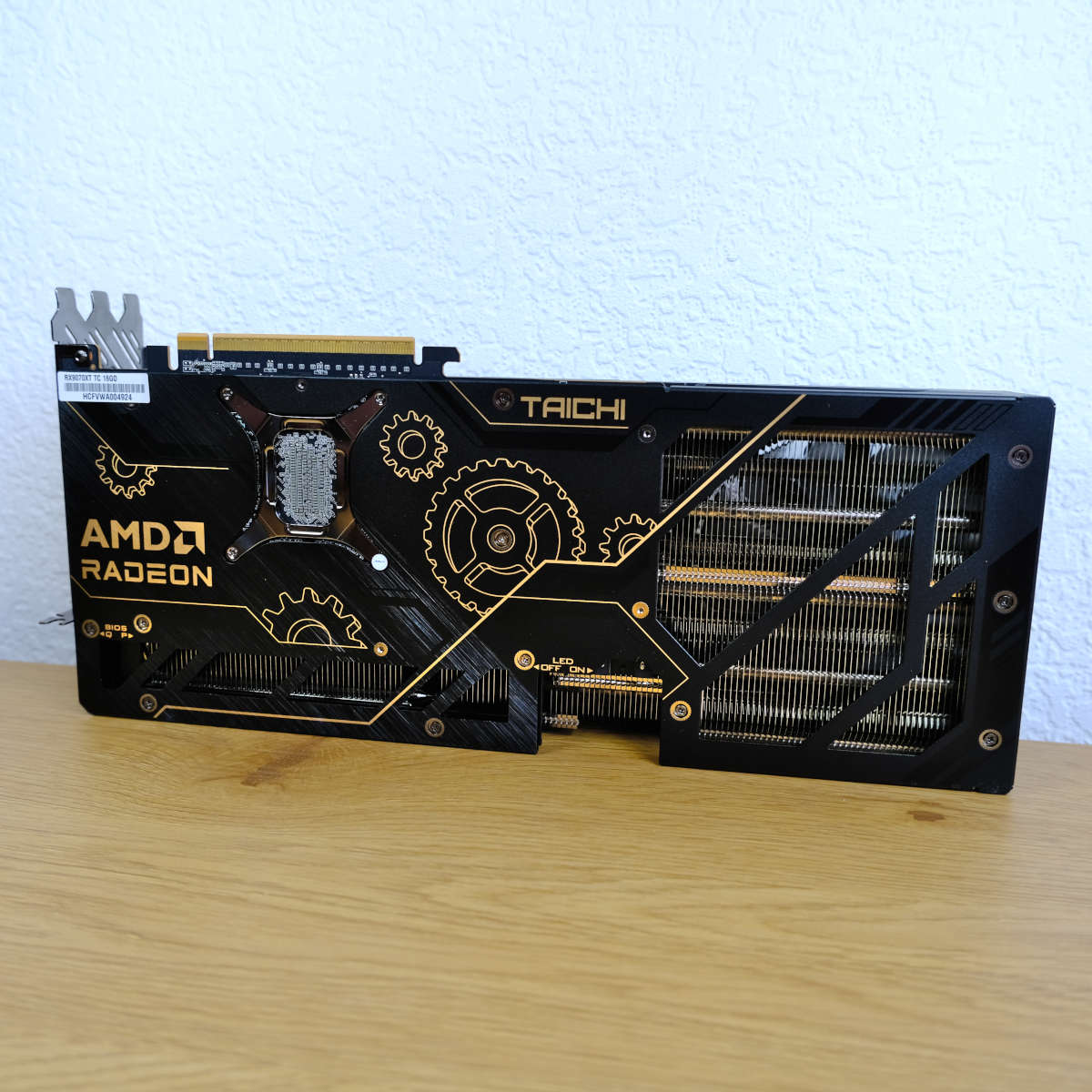
My fondness for ASRock’s use of cogs on its Taichi products extends to this graphics backplate. Given that computing is an almost entirely digital medium, its air of a more manual, mechanical time is welcomingly quaint. Kudos to the designer who placed one of the shrouds screws right in the middle of one of the cogs too.
Aesthetics aside, I appreciate that Taichi OC features clear labels for its LED and BIOS switches. The card arrives using its ‘P’ (Performance) profile but with quick flick you can engage its ‘Q’ (Quiet) profile instead. However, unless you’re going for the most-silent of builds there’s little reason to change it.
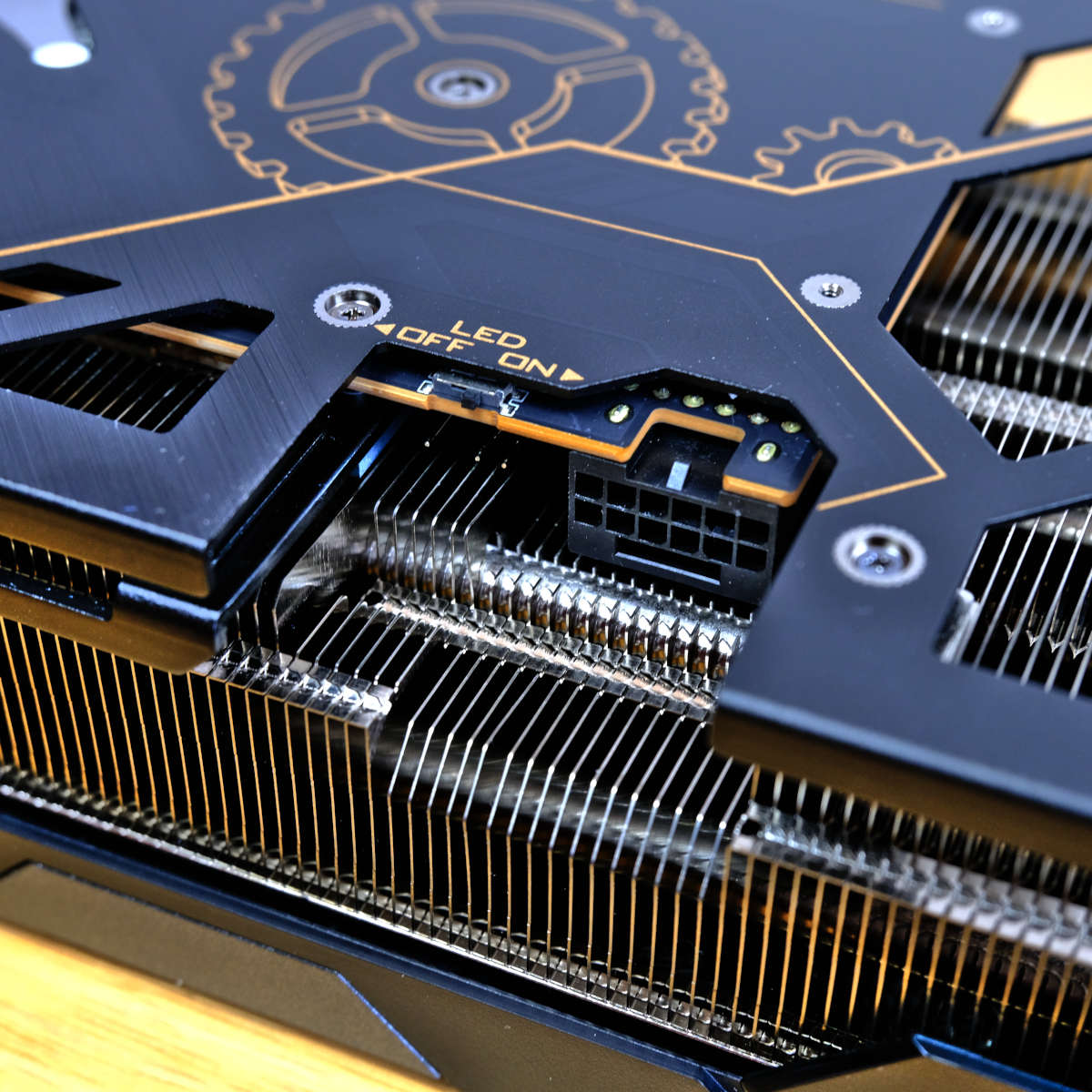
Finally, a word on power. Like the most-hungry Radeon RX 9070 XTs out there, this graphics card uses a 12V-2×6 connector in place of eight-pin headers. If you don’t have a native cable to hand, ASRock has you covered with an adapter.
Divisive as the 16-pin connector has become, I’m a fervent supporter. It isn’t difficult to ensure it’s sitting flush against the graphics card with due care and attention, and it’s far less faff to manage than the unsightly mass of wires eight-pin cables can create. This is the future, so better to get on board now.

Examining Taichi OC’s power consumption, it’s expectedly high. It’s the second-most power hungry graphics card on the board, sandwiched between AMD Radeon RX 7900 XTX and Nvidia GeForce RTX 3090, pulling 95W from the wall while idle and gobbling back 494W under load.
Remarkably, despite half a kW of electricity running through it, the graphics card remains impressively quiet and cool. During my testing, it was difficult to hear a peep out the fans with a noise profile of 35.5db, which doesn’t come at any detriment to temperatures either which peaked at 53°C. As a reminder this is using the ‘Performance’ BIOS, so there’s room to go even quieter too.
Performance
Another graphics card review means it’s time to fire up the Club386 test bench up once again. With an AMD Ryzen 9 7950X3D at its heart and other suitably high-end specifications, Taichi OC has all the support it needs to shine.
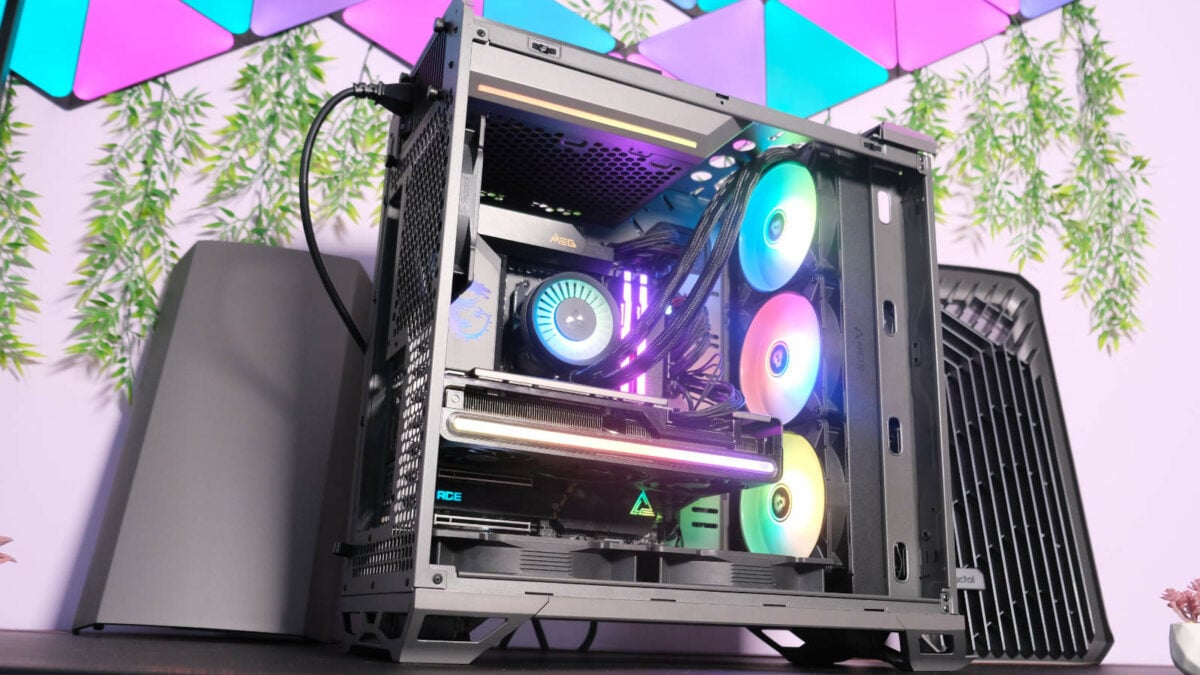
Our 7950X3D Test PCs
Club386 carefully chooses each component in a test bench to best suit the review at hand. When you view our benchmarks, you’re not just getting an opinion, but the results of rigorous testing carried out using hardware we trust.
Shop Club386 test platform components:
CPU: AMD Ryzen 9 7950X3D
Motherboard: MSI MEG X670E ACE
Cooler: Arctic Liquid Freezer III 420 A-RGB
Memory: 64GB Kingston Fury Beast DDR5
Storage: 2TB WD_Black SN850X NVMe SSD
PSU: be quiet! Dark Power Pro 13 1,300W
Chassis: Fractal Design Torrent Grey
Radeon RX 9070 XT is more than capable of handling resolutions up to and including 4K, so I’m testing the card at UHD, QHD, and FHD. I’m also running some tests that’ll showcase its deep learning capabilities.
Application & AI
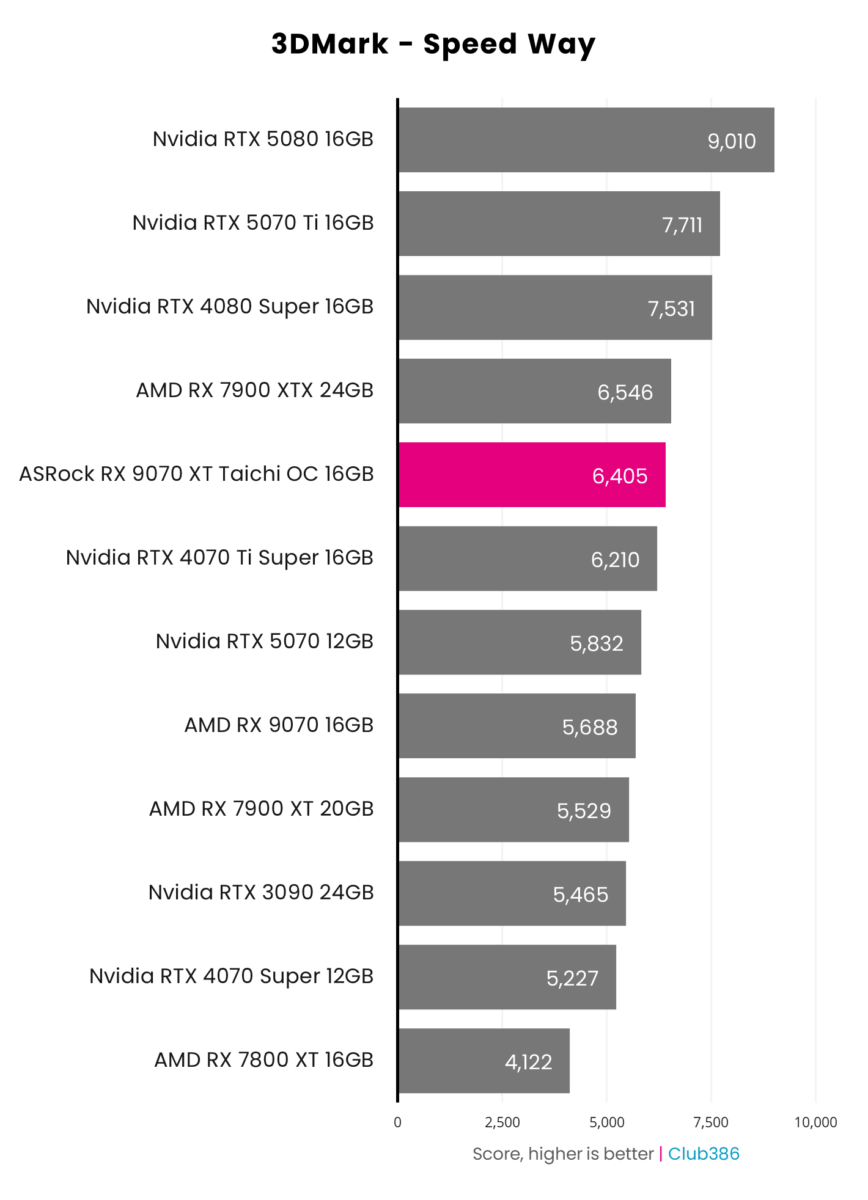

Taichi OC delivers the highest scores I’ve seen from a Radeon RX 9070 XT in 3DMark Speed Way and Steel Nomad. Its class-leading clock speeds are truly pulling their weight.
The card expectedly boasts fantastic rasterised rendering qualities, beating Radeon RX 7900 XTX. More importantly, AMD’s new contender smashes both GeForce RTX 5070 and RTX 5070 Ti’s scores.
While Radeon RX 9070 XT doesn’t move the ray tracing needle past RX 7900 XTX, it does keep pace with it. This makes the card comparable to GeForce RTX 4070 Ti Super, beating RTX 5070 but falling behind RTX 5070 Ti.
Of course, the synthetic results above are more of an estimation of each model’s performance than wholly indicative of real-world capabilities. I’ll dive into gaming benchmarks shortly.
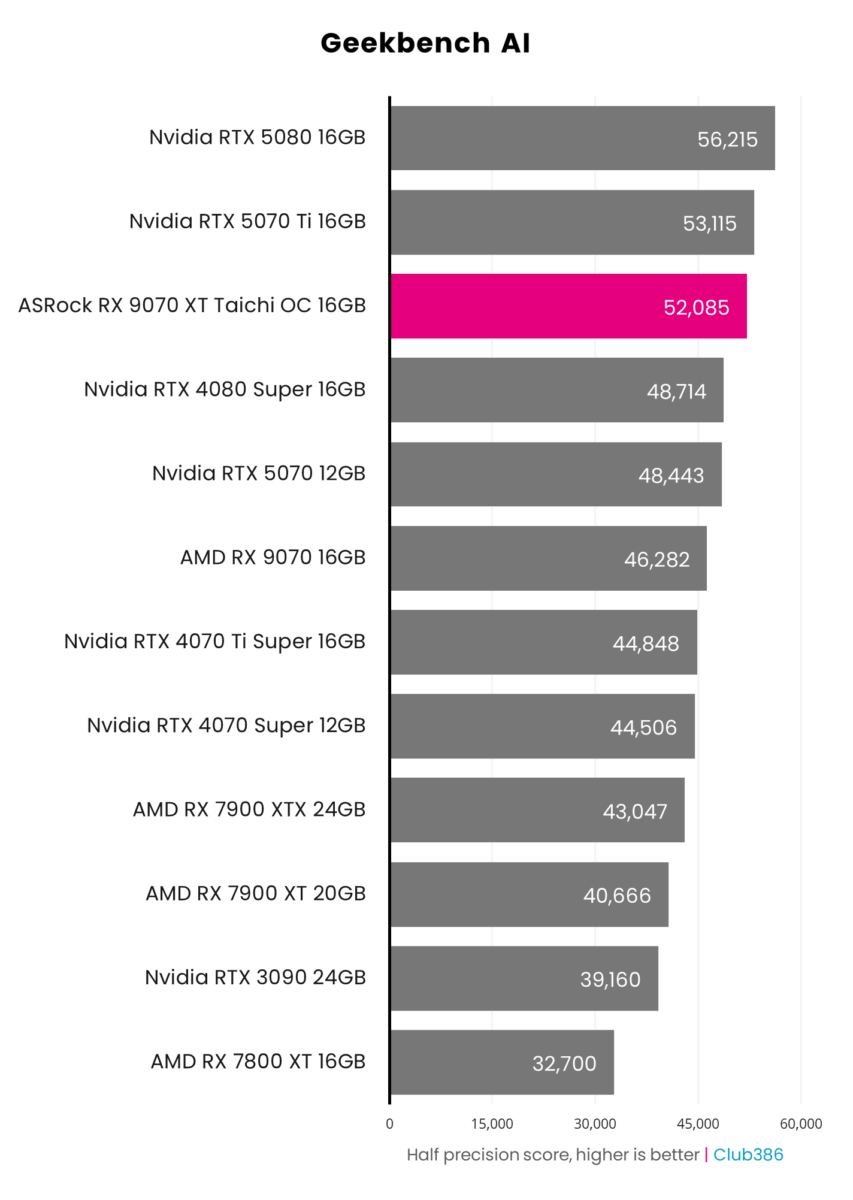
AMD’s new AI accelerators are significantly more performant than their forebears, as Radeon RX 9070 XT pulls ahead of 7900 XTX’s half precision score in Geekbench AI by 21%. This feat is all the more impressive considering that the new card has fewer accelerators at its disposal (128 vs. 192).
The five extra FP16 TOPS, 102 total, afforded by Taichi OC’s higher clocks aren’t enough to usurp GeForce RTX 5070 Ti from its more-prestigious podium position. That said, were I Nvidia, I’d view the gap between them as uncomfortably close.
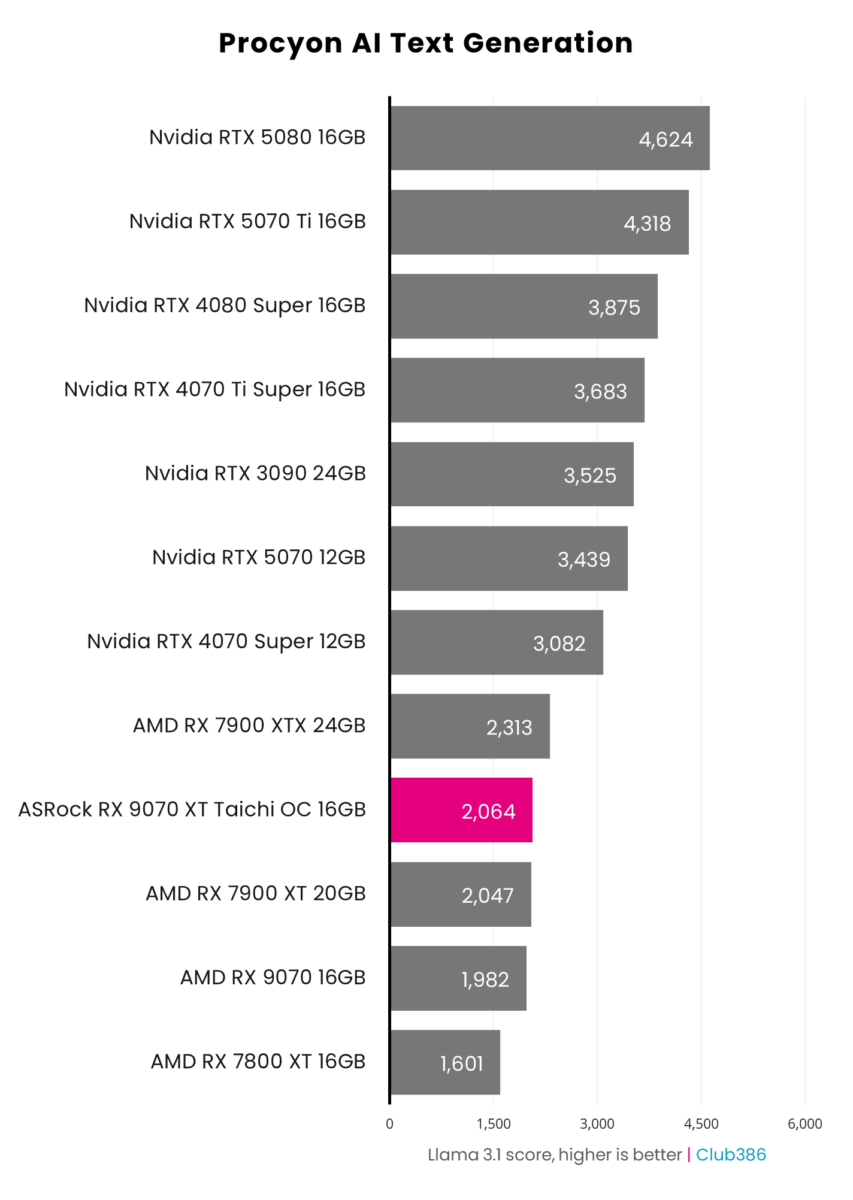
Unfortunately, Radeon RX 9070 XT does little to address relatively poor LLM (Large Language Model) performance. Its 16GB buffer improves compatibility with more-demanding models but AMD has plenty of work to do elsewhere, as even Nvidia GeForce RTX 4070 Super comfortably beats its new GPU.
Gaming
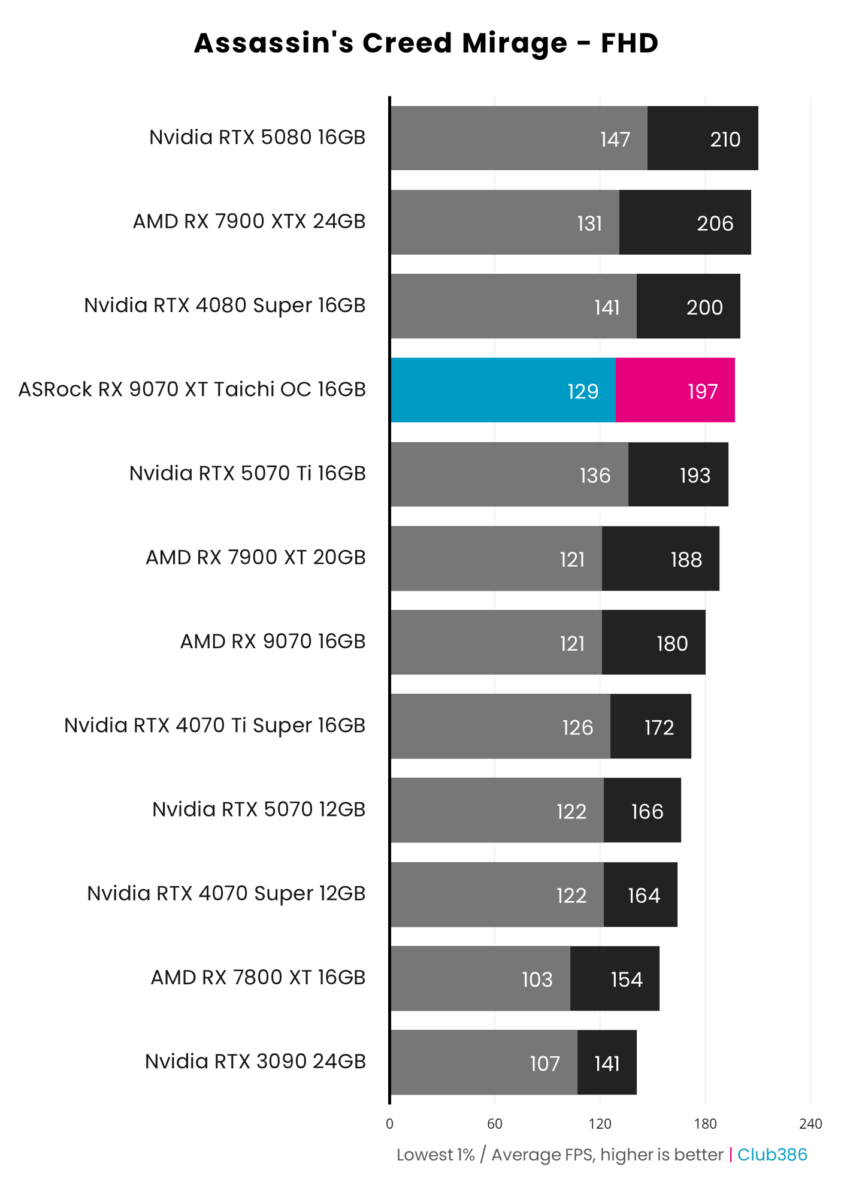
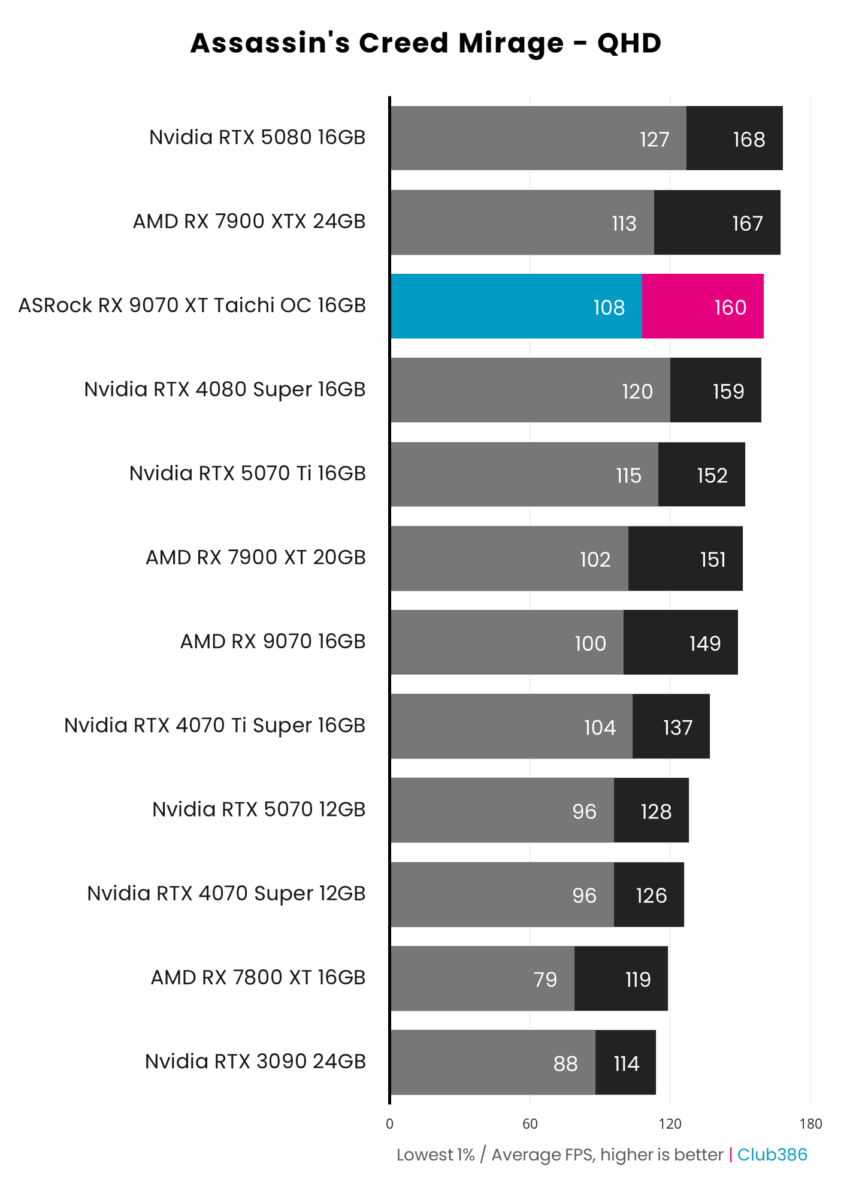
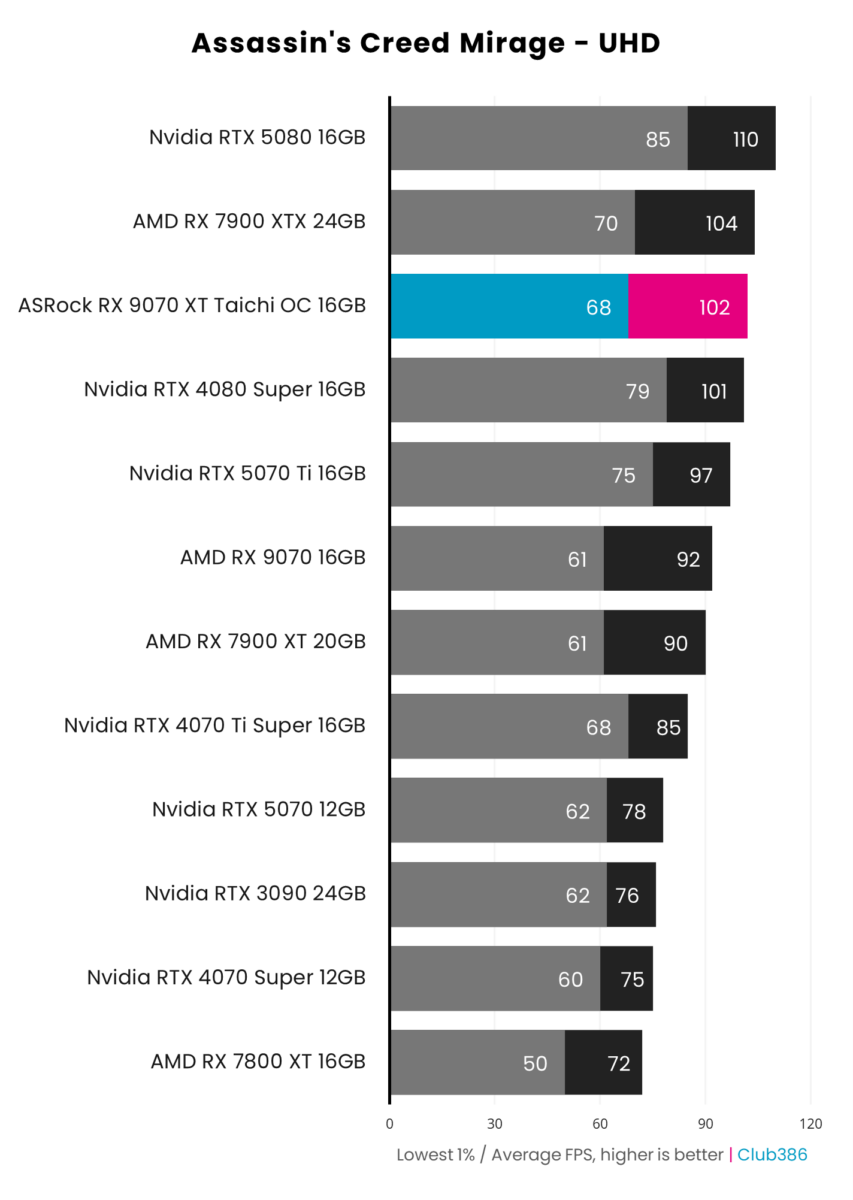
Taichi OC glides across the rooftops of Baghdad in Assassin’s Creed Mirage. The card pumps out over 100fps on average at QHD, and UHD while also falling just shy of 200fps at FHD.
At each resolution, this Radeon RX 9070 XT handily defeats GeForce RTX 5070 Ti and RTX 5070, showcasing the might of RDNA 4’s rasterised rendering chops over Blackwell.
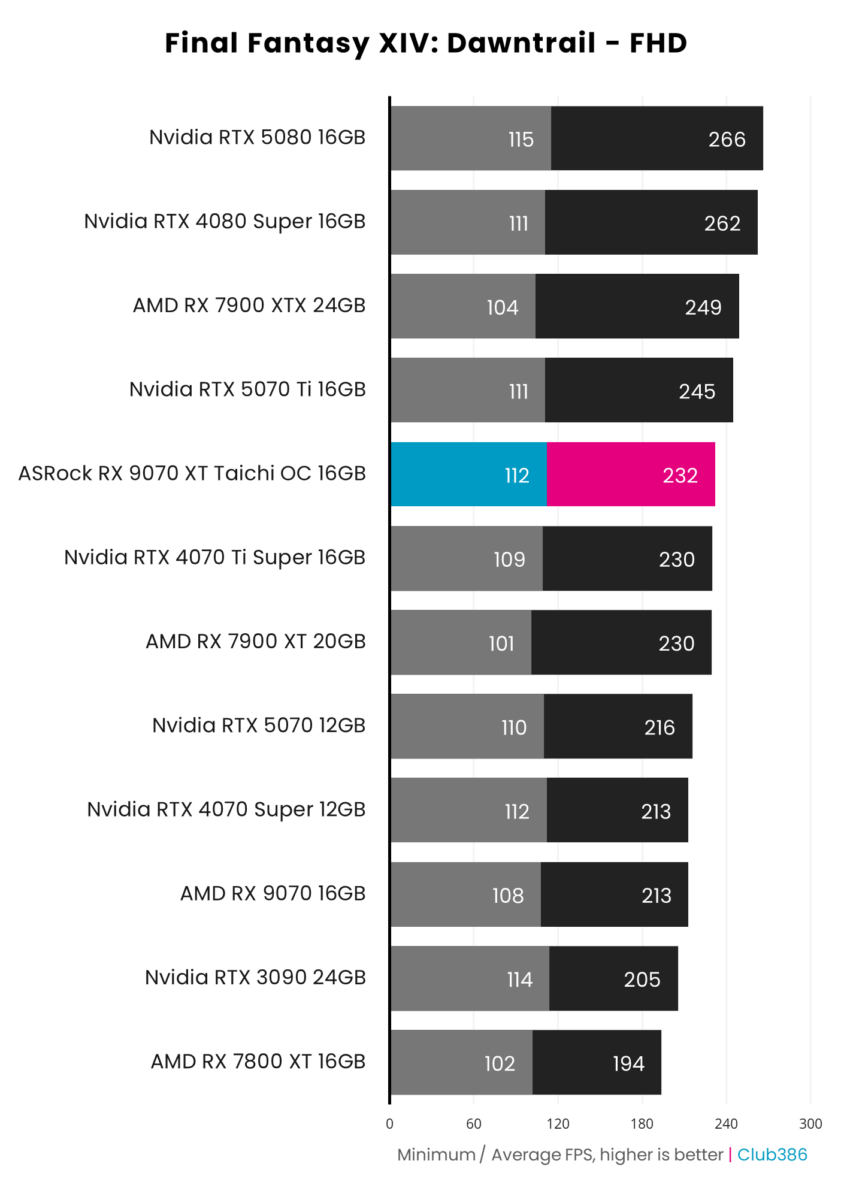
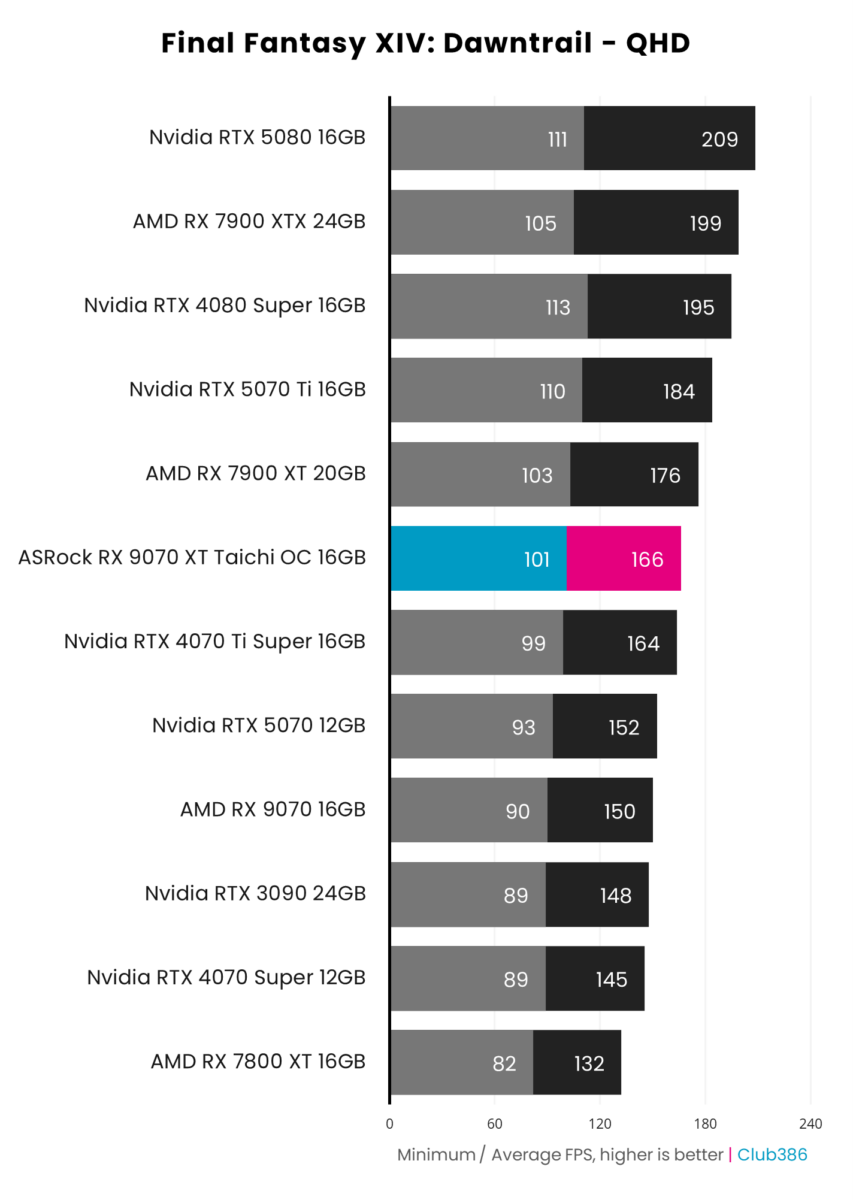
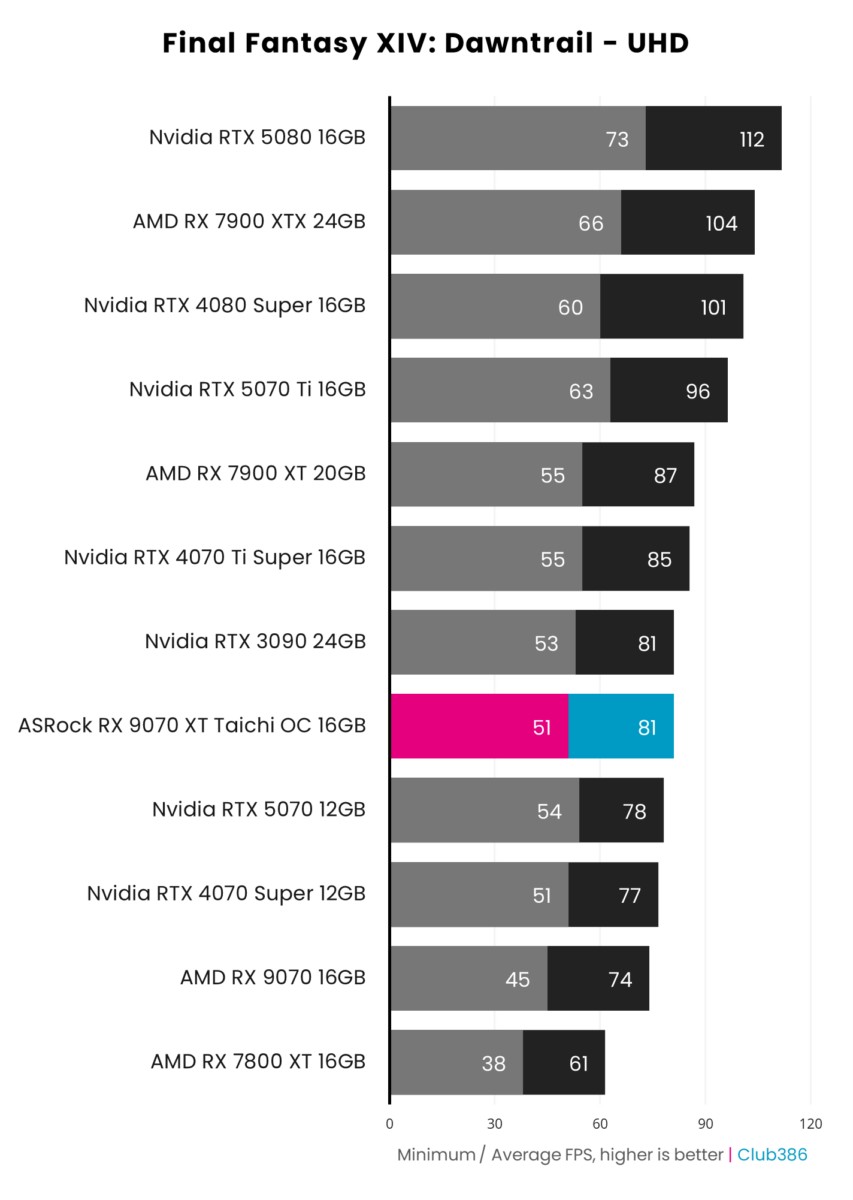
Final Fantasy XIV: Dawntrail typically favours Nvidia graphics cards, likely in part due to its use of Nvidia GameWorks technologies. Much as the race is in the favour of GeForce, Radeon RX 9070 XT still respectably holds its own and maintains a lead over RTX 5070.
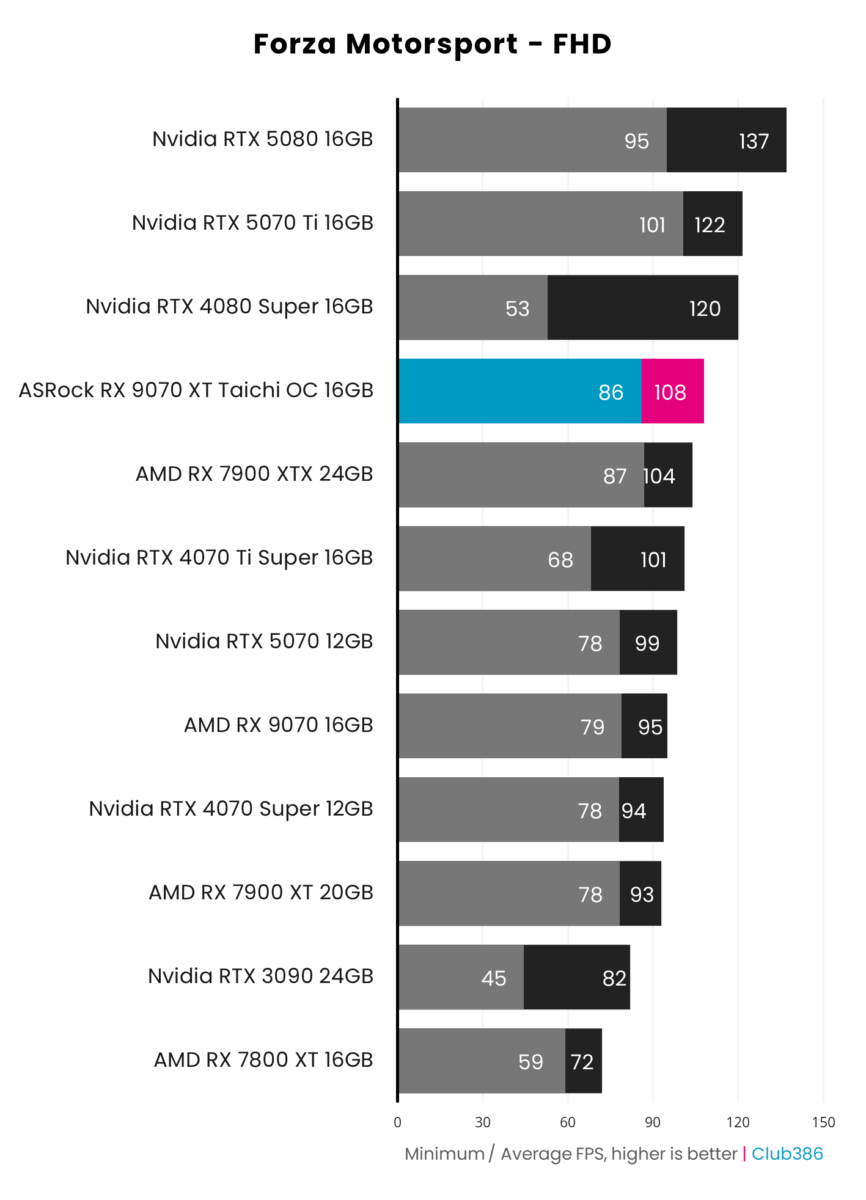
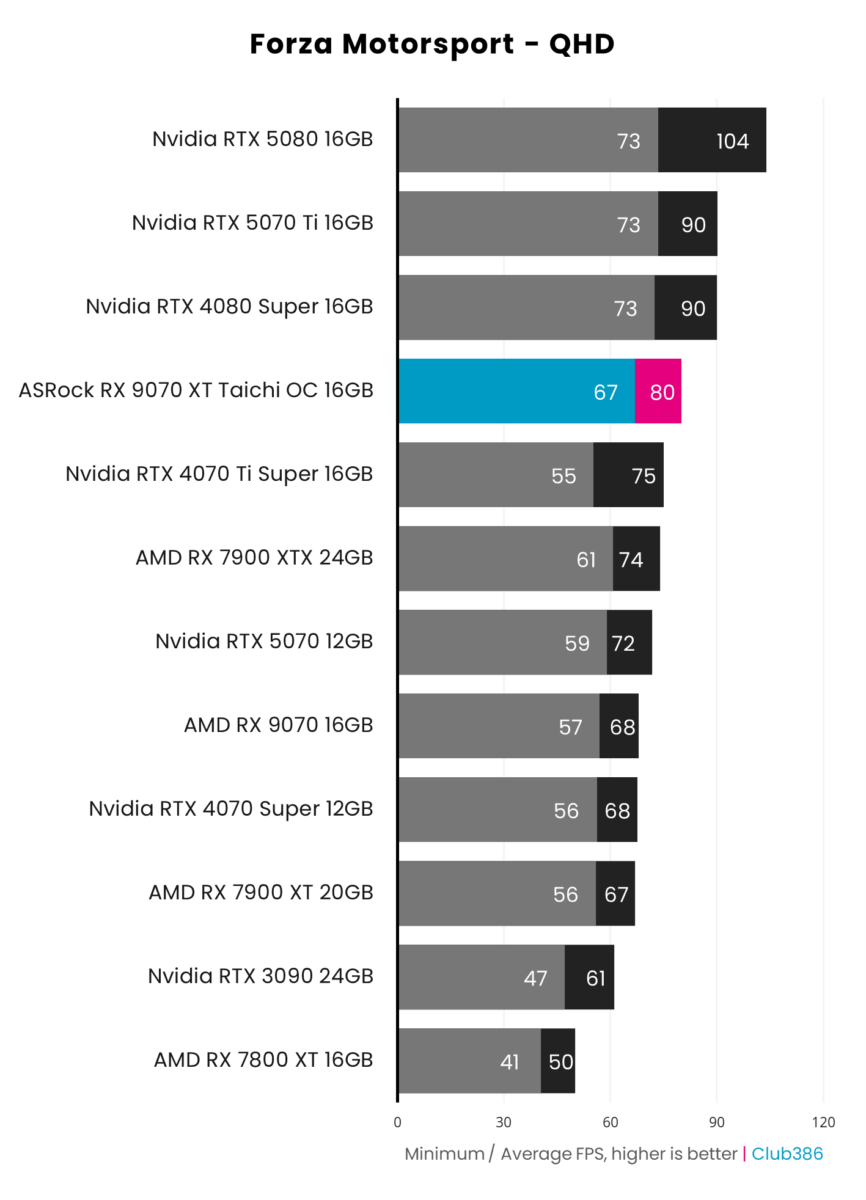
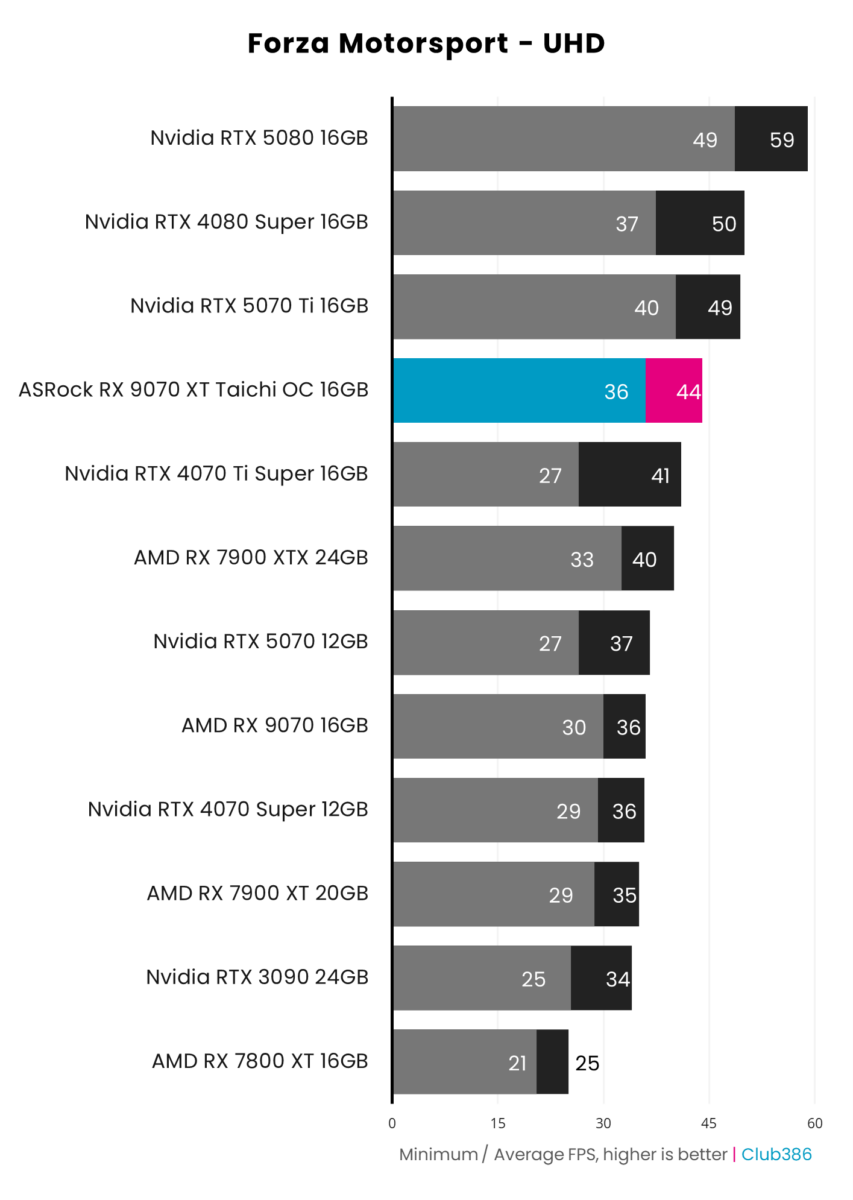
Forza Motorsport proves an exciting race between Radeon RX 9070 XT and its closest GeForce rivals, sandwiching itself between RTX 5070 Ti and RTX 5070. Make no mistake, this card’s no slouch when it comes to ray tracing on these tracks, though upscaling is a must at UHD.
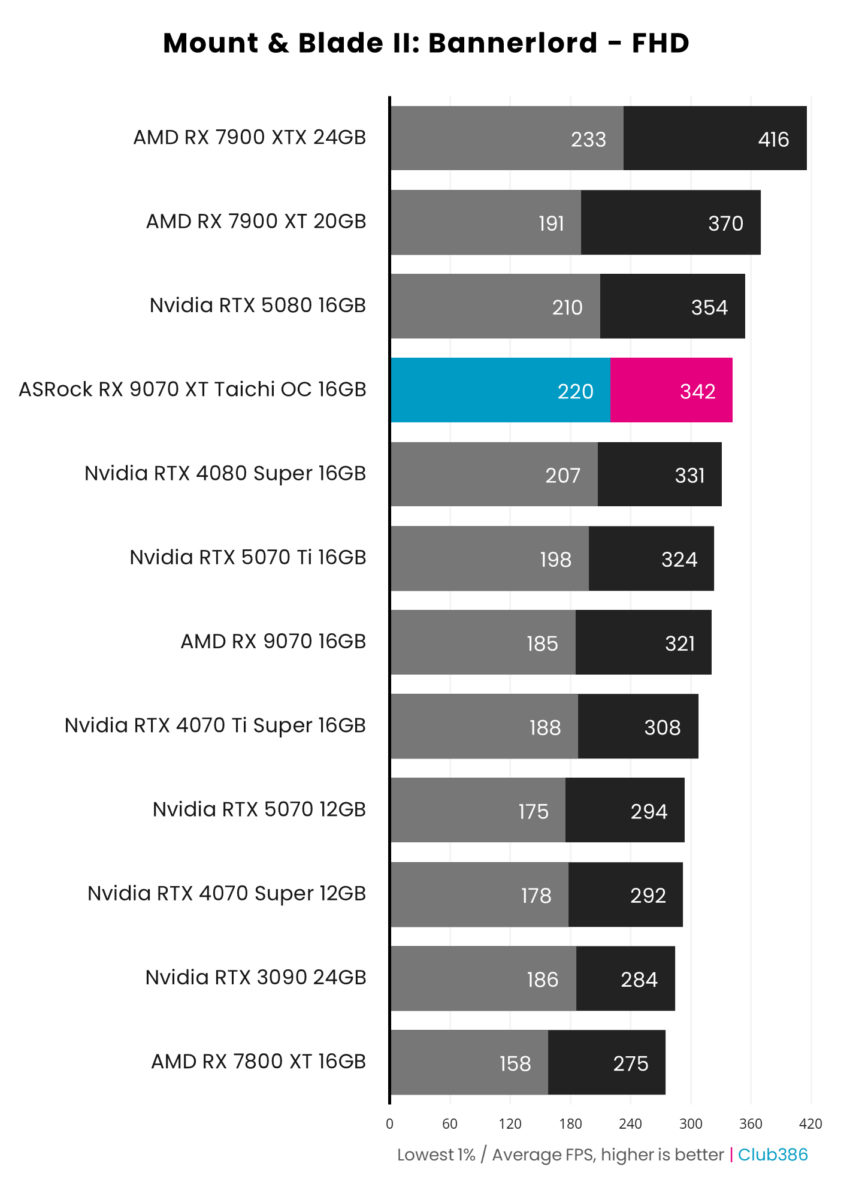
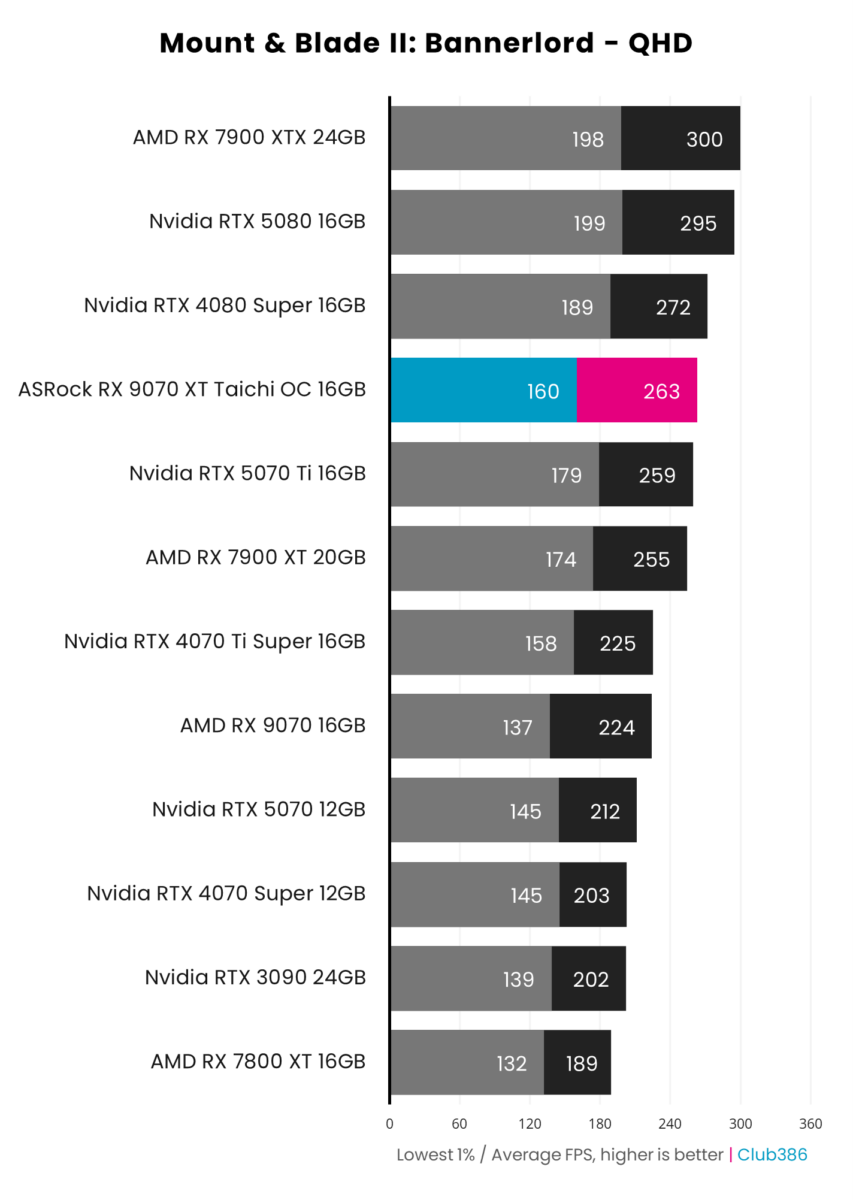
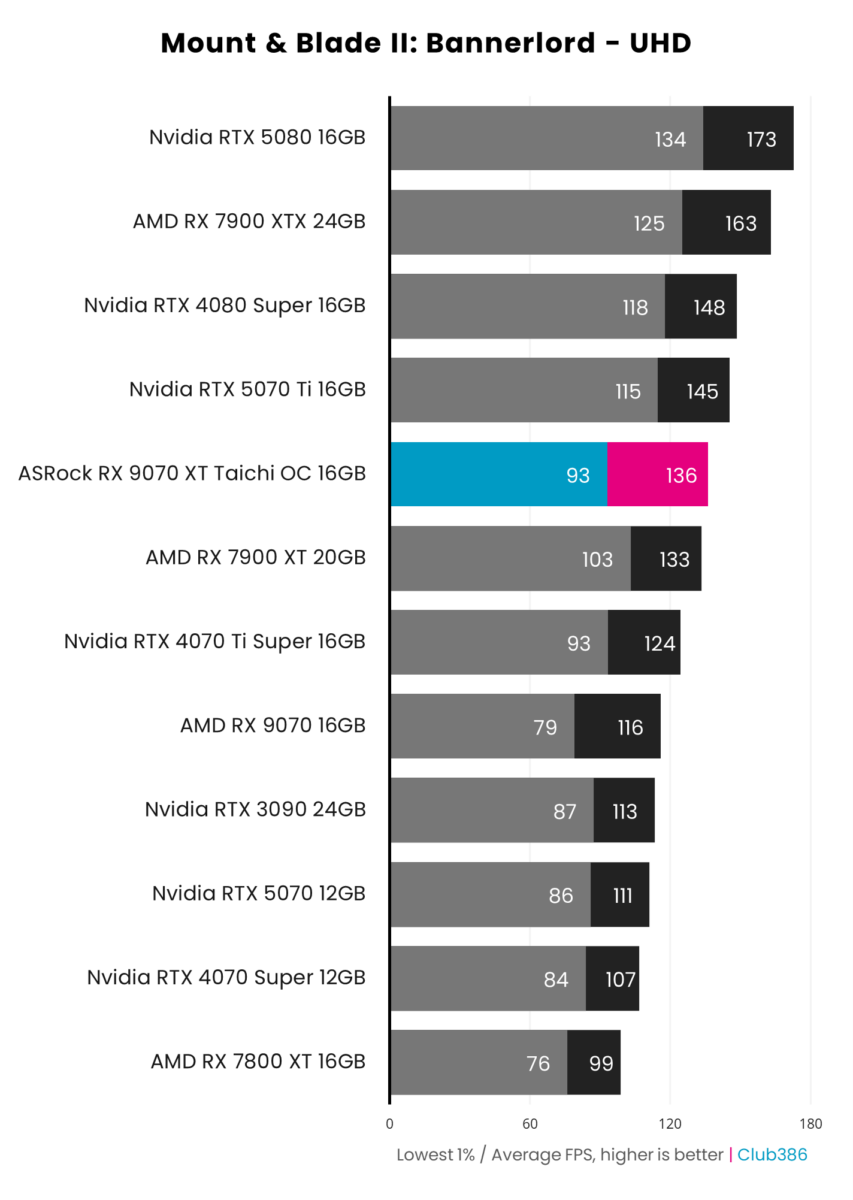
Regardless of resolution, Radeon RX 9070 XT takes to battle in Mount & Blade II like a seasoned warrior atop a thoroughbred. The relative performance of the card strangely declines as the weight of higher resolutions presses down on it, but it still delivers impressively high average frame rates even at UHD.
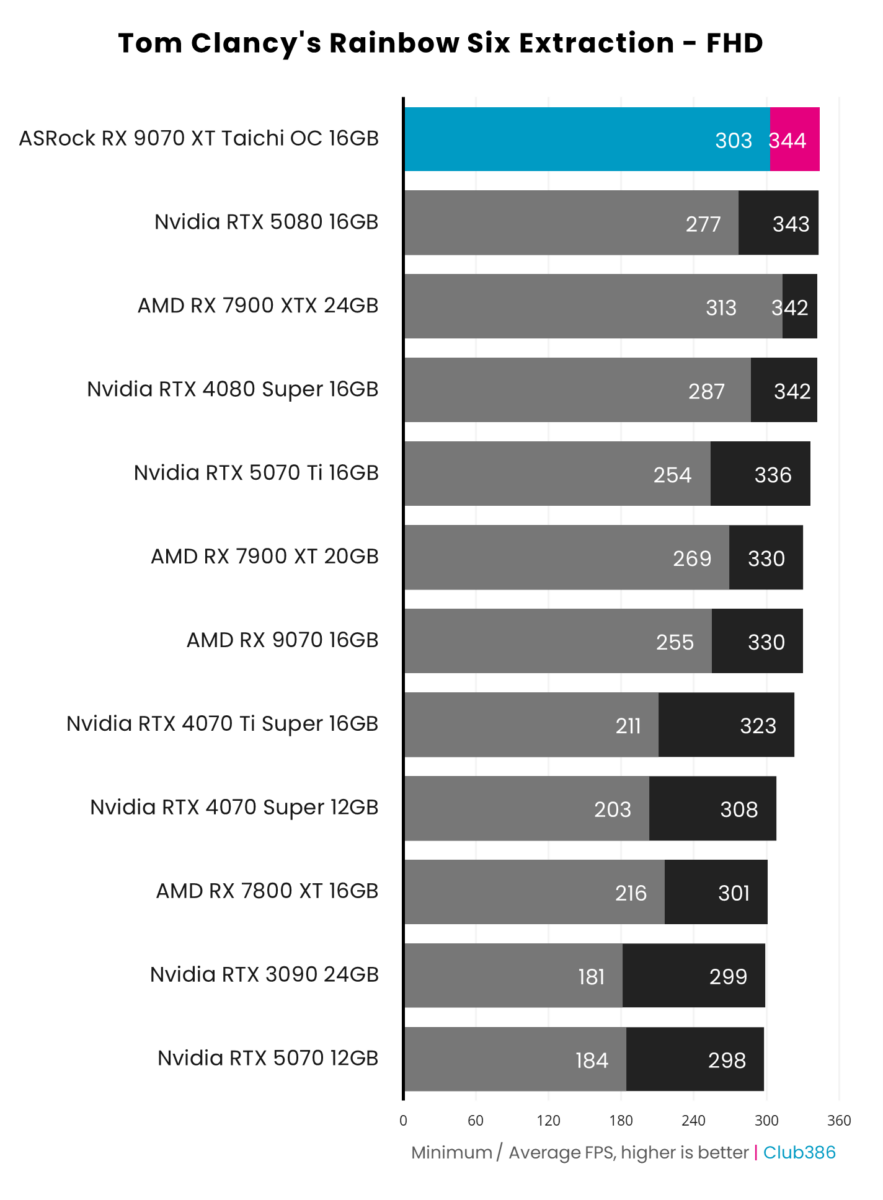
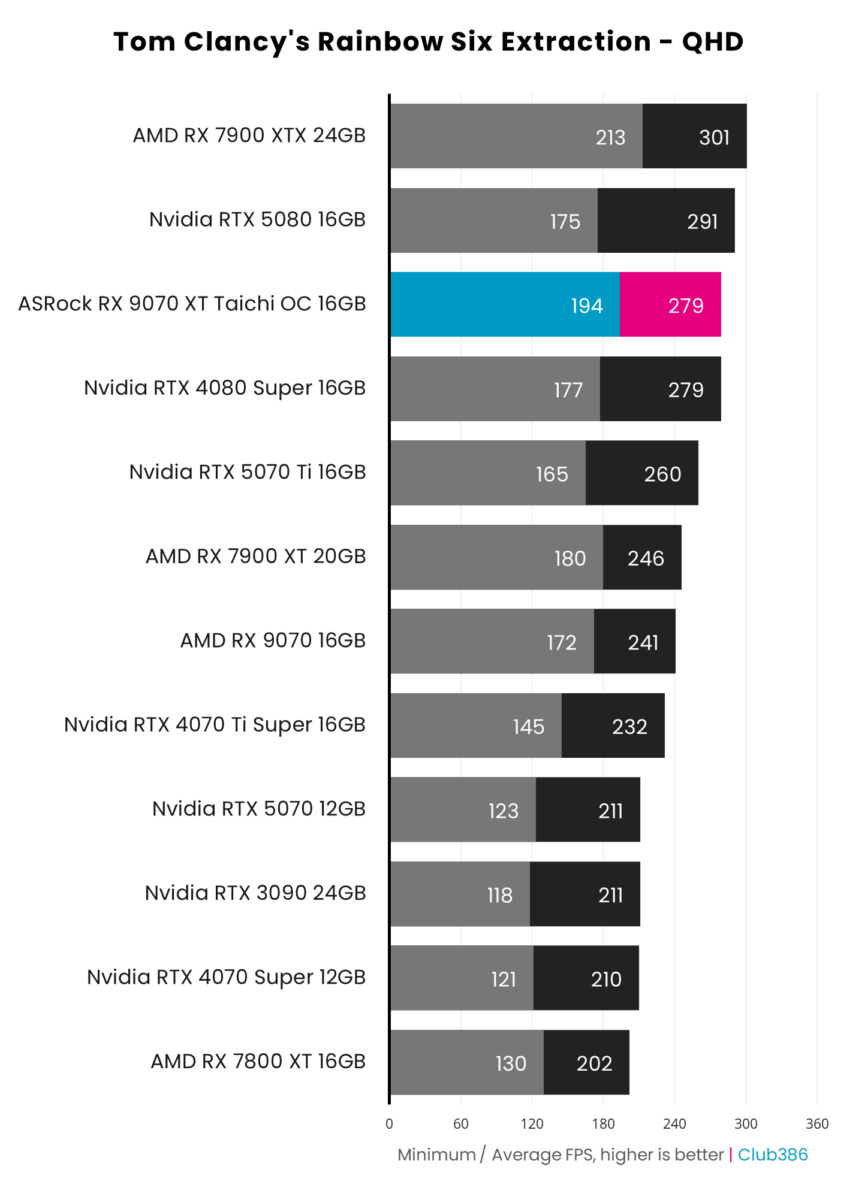
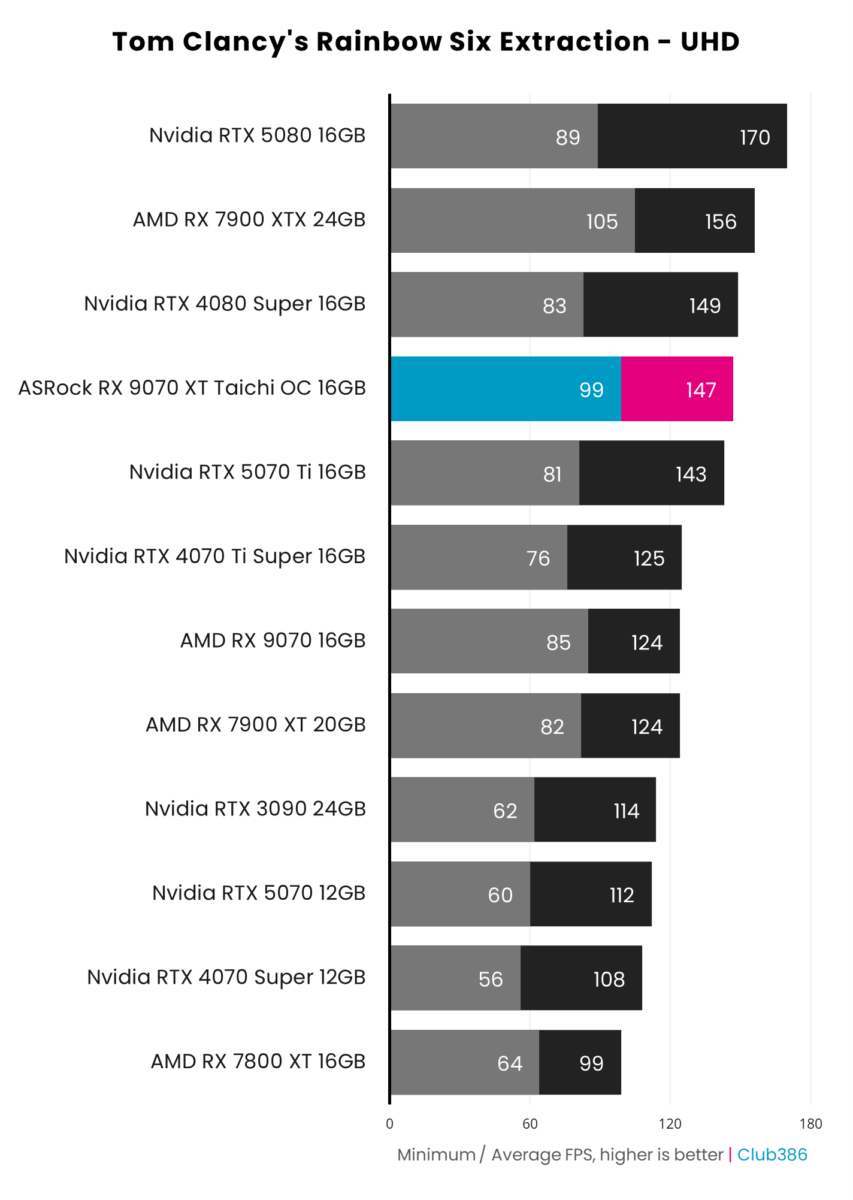
Radeon RX 9070 XT serves a final flourish in Rainbow Six Extraction, topping the charts at FHD and maintaining a lead over GeForce RTX 5070 Ti at QHD as well as UHD. Cinematic or competitive, this graphics card has no problem handling either style of game.
It’s important to note that while AMD Anti-Lag 2 will reduce latency like Nvidia Reflex, it’s not quite as common. The tech is available in many popular competitive shooters including Counter-Strike 2 and Marvel Rivals but is missing from the likes of Valorant.
AMD FSR
Like all other Radeon RX 9070 XT graphics cards, Taichi OC supports the entire AMD FSR 4 suite. The flagship feature for this latest iteration is AI upscaling, bringing Team Red’s offerings in line with the likes of Nvidia DLSS and Intel XeSS.
FSR 4 upscaling is genuinely impressive from an image quality standpoint, as I explored in a previous review. Its only major drawback for the moment is a relative lack of availability to prior versions and its competitors but this will naturally improve over time. However, clever clogs are already working hard to make it easy to replace DLSS and/or XeSS with FSR 4 via mods.
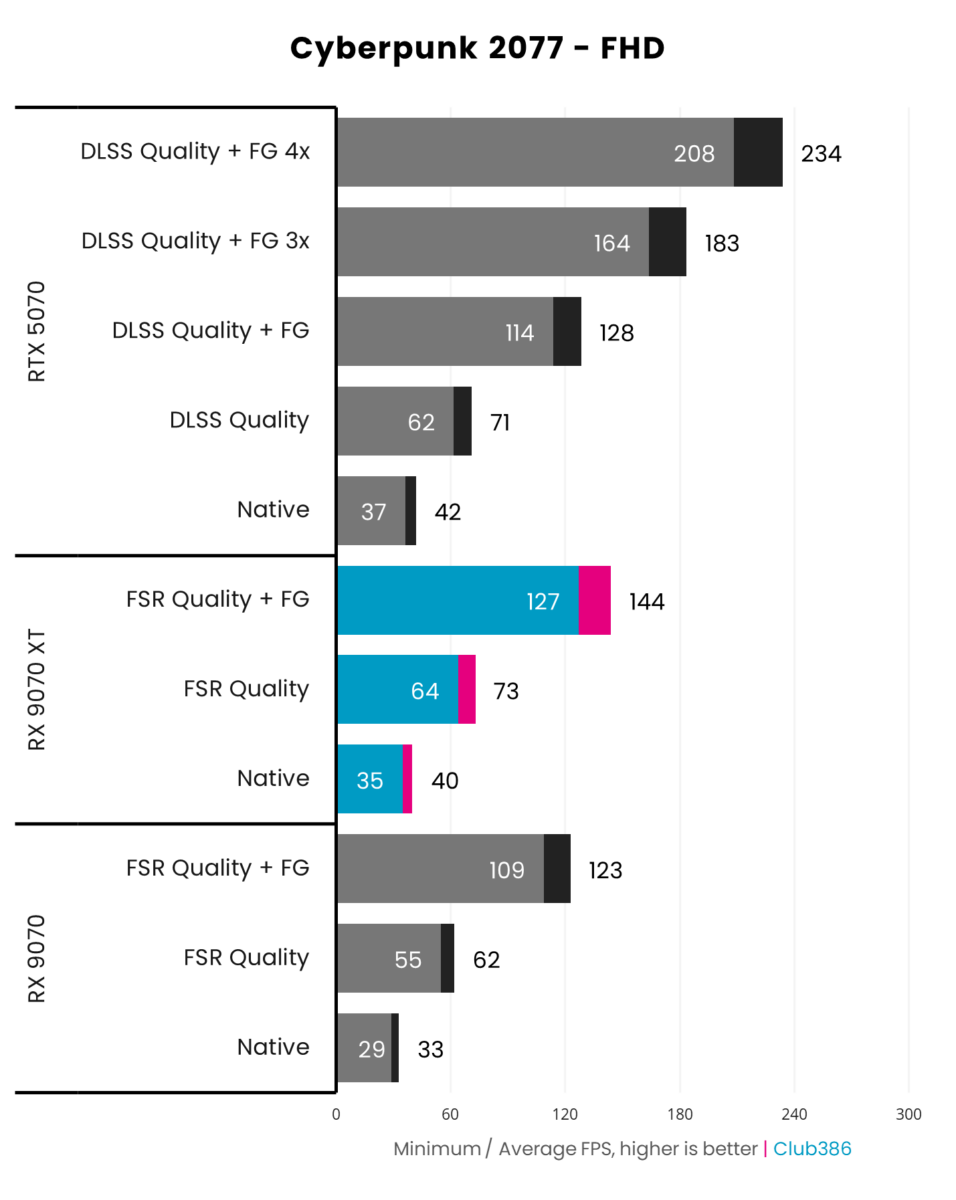
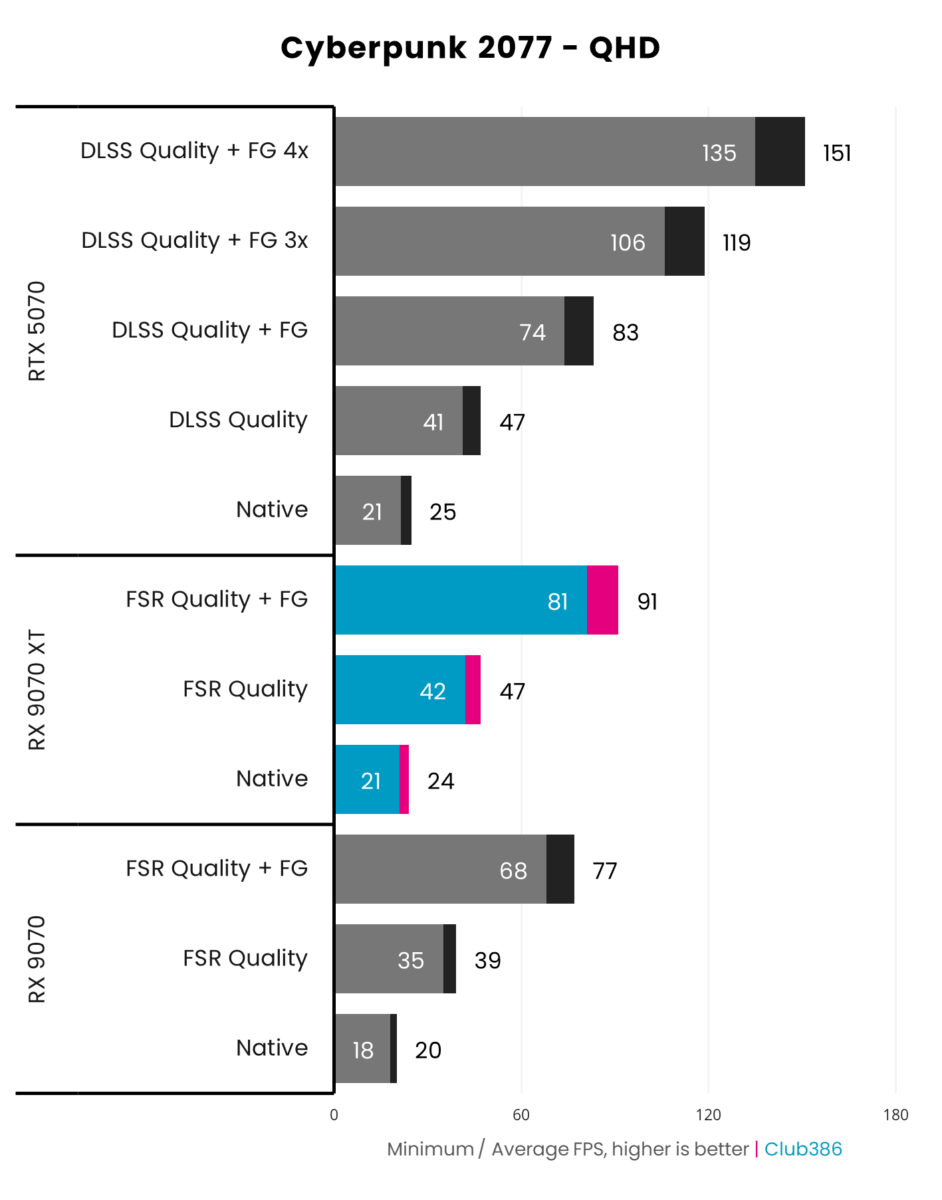
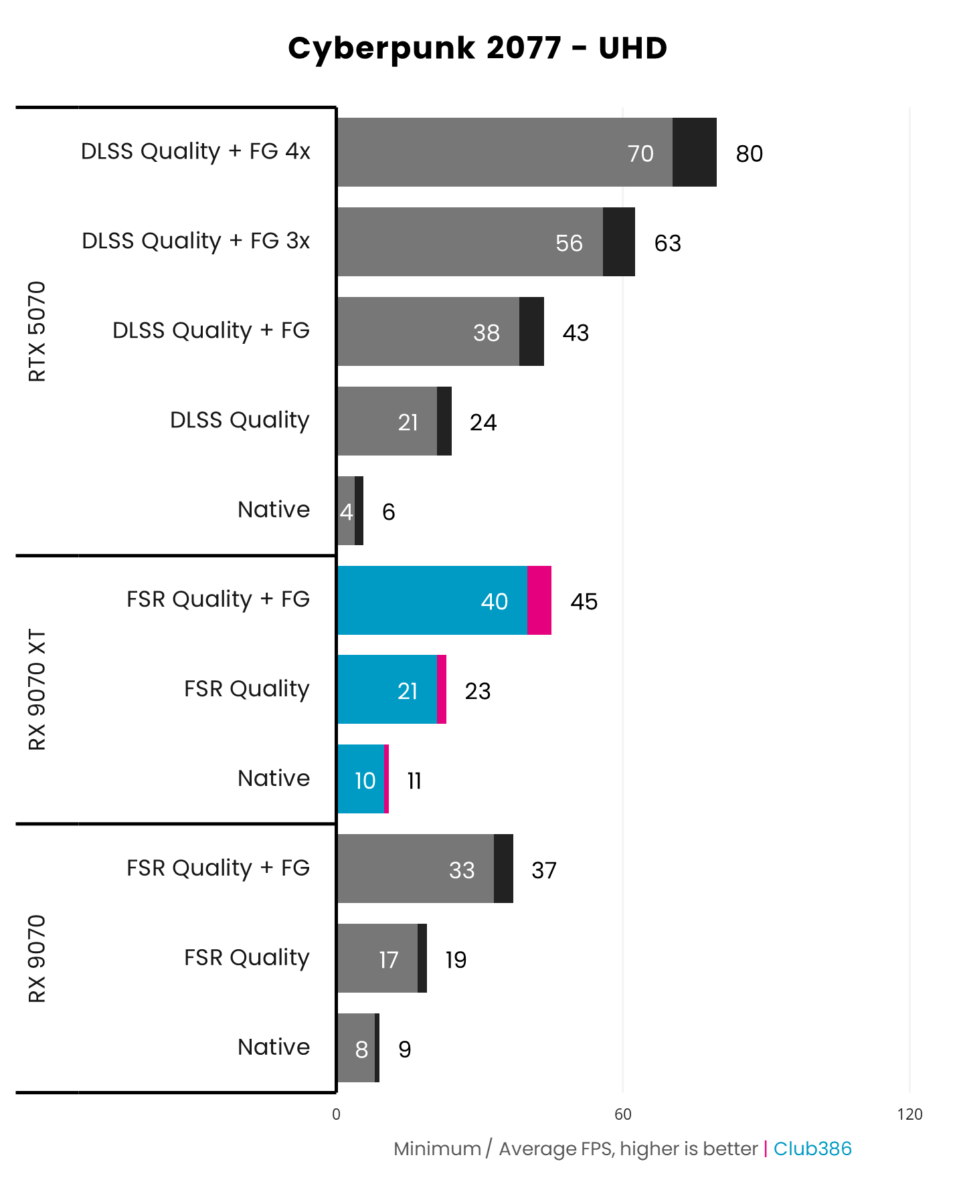
There’s little performance penalty associated with FSR 4 based on my testing, so frame rates accrued using FSR 3/3.1 will be broadly indicative of the newer tech too. With this in mind, Cyberpunk 2077 unfortunately doesn’t support AMD’s new upscaler but should perform similarly should it ever arrive.
The game’s ‘RT: Overdrive’ preset pushes Taichi OC to its limits, alongside GeForce RTX 5070 and Radeon RX 9070. None of the cards are able to punch north of 60fps without the aid of upscalers, but you need an Nvidia GeForce RTX 5080 at minimum to accomplish that at FHD alone.
Radeon RX 9070 XT remains competitive with RTX 5070 once FSR and DLSS are in play, even clipping past its competition turning on frame generation. However, Nvidia’s Multi Frame Generation sees the Blackwell card charge miles ahead.
Conclusion
ASRock Taichi OC easily ranks among the best Radeon RX 9070 XT graphics cards you can buy. It’s stylish, well-built, and delivers all the performance you could want out of AMD’s Navi 48 GPU. Truly, cost is the only thing working against its favour.
The splendour of this model diminishes a touch taking into account its $730 / £730 price tag. However, this is a premium variant that doesn’t compromise in any manner, which naturally comes with the expectation of paying more.

It’s worth considering GeForce RTX 5070 Ti at this price, though you’re unlikely to find one as high quality for the same money as Taichi OC, if at all due to ongoing issues surrounding availability. To be fair, finding Radeon RX 9070 XT at the moment is also difficult.
If you’re in search of the very best Radeon RX 9070 XT money can buy, then Taichi OC should be your first port of call. With a flexible enough budget, it’s my preferred choice but value-oriented shoppers should look to ASRock’s Steel Legend which will admittedly deliver the lion’s share of performance on offer here.


